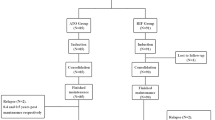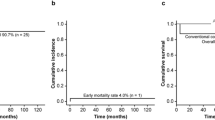Abstract
Objective
To compare the clinical effect of arsenic-containing Qinghuang Powder (QHP) and low-intensity chemotherapy (LIC) in treatment of elderly acute myeloid leukemia (eAML) patients.
Methods
Clinical data of 80 eAML patients treated at Xiyuan Hospital of China Academy of Chinese Medical Sciences from January 2015 to December 2020 were retrospectively analyzed. The treatment scheme was designed by real world study according to patients’ preference, and patients were divided into a QHP group (35 cases) and a LIC group (45 cases). The median overall survival (mOS), 1-, 2-, and 3-year OS rates, and incidence of adverse events were compared between the two groups.
Results
The mOS of 80 patients was 11 months, and the 1-, 2-, and 3-year OS rates were 45.51%, 17.96%, and 11.05%, respectively. The QHP and LIC groups demonstrated no significant difference in mOS (12 months vs. 10 months), 1- (48.57% vs. 39.65%), 2- (11.43% vs. 20.04%), and 3-year OS rates (5.71% vs. 13.27%, all P>0.05). Moreover, the related factors of mOS demonstrated no significant difference in patients with age>75 years (11 months vs. 8 months), secondary AML (11 months vs. 8 months), poor genetic prognosis (9 months vs. 7 months), Eastern Cooperative Oncology Group performance status score ⩾ 3 (10 months vs. 7 months) and hematopoietic stem cell transplant comorbidity index ⩾ 4 (11 months vs. 7 months) between the QHP and LIC groups (all P>0.05). However, the incidence of myelosuppression was significantly lower in the QHP group than that in the LIC group (28.57% vs. 73.33%, P<0.01).
Conclusions
QHP and LIC had similar survival rates in eAML patients, but QHP had a lower myelosuppression incidence. Hence, QHP can be an alternative for eAML patients who do not tolerate LIC.
Similar content being viewed by others
References
Wadai GM. Evaluation of serum interleukin-15 in acute lymphoid and myeloid leukemia patients. Arch Razi Institute 2022;77:1895–1899.
Mangaonkar AA, Patnaik MM. Patterns of care and survival for elderly acute myeloid leukemia-challenges and opportunities. Curr Hematol Malig Rep 2017;12:290–299.
Shallis RM, Wang R, Davidoff A, Ma X, Zeidan AM. Epidemiology of acute myeloid leukemia: recent progress and enduring challenges. Blood Rev 2019;36:70–87.
Yoo KH, Cho J, Han B, Kim SH, Shin DY, Hong J, et al. Outcomes of decitabine treatment for newly diagnosed acute myeloid leukemia in older adults. PLoS One 2020;15:e0235503.
Jiang L, Li XP, Dai YT, Chen B, Weng XQ, Xiong SM, et al. Multidimensional study of the heterogeneity of leukemia cells in t(8;21) acute myelogenous leukemia identifies the subtype with poor outcome. Proc Natl Acad Sci U S A 2020;117:20117–20126.
Giannopoulos K. Targeting immune signaling checkpoints in acute myeloid leukemia. J Clin Med 2019;8:236.
Blecua P, Martinet-Verbo L, Esteller M. The DNA methylation landscape of hematological malignancies: an update. Mol Oncol 2020;14:1616–1639.
Bohl SR, Bullinger L, Rucker FG. Epigenetic therapy: azacytidine and decitabine in acute myeloid leukemia. Exp Rev Hematol 2018;11:361–371.
Wen BB, You WW, Yang S, Du X. Indirect comparison of azacitidine and decitabine for the therapy of elderly patients with acute myeloid leukemia: a systematic review and network meta-analysis. Exp Hematol Oncol 2020;9:3.
DiNardo CD, Jonas BA, Pullarkat V, Thirman MJ, Garcia JS, Wei AH, et al. Azacitidine and venetoclax in previously untreated acute myeloid leukemia. N Engl J Med 2020;383:617–629.
Cortes J, Perl AE, Dohner H, Kantarjian H, Martinelli G, Kovacsovics T, et al. Quizartinib, an FLT3 inhibitor, as monotherapy in patients with relapsed or refractory acute myeloid leukaemia: an open-label, multicentre, single-arm, phase 2 trial. Lancet Oncol 2018;19:889–903.
Daver N, Boddu P, Garcia-Manero G, Yadav SS, Sharma P, Allison J, et al. Hypomethylating agents in combination with immune checkpoint inhibitors in acute myeloid leukemia and myelodysplastic syndromes. Leukemia 2018;32:1094–1105.
Deng ZY, Zhu SR, Wang MJ, Fang S, Zhao P, Zhu QZ, et al. Relation of blood arsenic concentration with effect and safety of arsenic-containing Qinghuang Powder in patients with myelodysplastic syndrome. Chin J Integr Med 2019;25:497–501.
Zhao P, Liang JB, Deng ZY, Wang MJ, Qin JY, Chen CJ, et al. Association of gene mutations with response to arsenic-containing compound Qinghuang Powder in patients with myelodysplastic syndromes. Chin J Integr Med 2019;25:409–415.
Vardiman JW, Thiele J, Arber DA, Brunning RD, Borowitz MJ, Porwit A, et al. The 2008 revision of the World Health Organization (WHO) classification of myeloid neoplasms and acute leukemia: rationale and important changes. Blood 2009;114:937–951.
Arber DA, Orazi A, Hasserjian R, Thiele J, Borowitz MJ, Le Beau MM, et al. The 2016 revision to the World Health Organization classification of myeloid neoplasms and acute leukemia. Blood 2016;127:2391–2405.
Simons A, Shaffer LG, Hastings RJ. Cytogenetic nomenclature: changes in the ISCN 2013 compared to the 2009 edition. Cytogenet Genome Res 2013;141:1–6.
O’Donnell MR, Tallman MS, Abboud CN, Altman JK, Appelbaum FR, Arber DA, et al. Acute myeloid leukemia, version 3. 2017, NCCN Clinical Practice Guidelines in Oncology. J Natl Compr Canc Netw 2017;15:926–957.
Sorror ML, Maris MB, Storb R, Baron F, Sandmaier BM, Maloney DG, et al. Hematopoietic cell transplantation (HCT)-specific comorbidity index: a new tool for risk assessment before allogeneic HCT. Blood 2005;106:2912–2919.
Cheson BD, Bennett JM, Kopecky KJ, Büchner T, Willman CL, Estey EH, et al. Revised recommendations of the International Working Group for diagnosis, standardization of response criteria, treatment outcomes, and reporting standards for therapeutic trials in acute myeloid leukemia. J Clin Oncol 2004;22:3432–3333.
Li GH, Li DH, Fan YZ, Chen RA, Ji YR, Qin WW, et al. Clinical outcome of decitabine combined with CAG regimen for treatment of acute myeloid leukemia ineligible for conventional chemotherapy. J Leuk Lymphoma 2017;26:280–282, 286.
Leukemia & Lymphoma Group, Chinese Society of Hematology, Chinese Medical Association. Chinese guidelines for the diagnosis and treatment of adult acute myeloid leukemia (not APL) (2021). Chin J Hematol (Chin) 2021;42:617–623.
Sherman AE, Motyckova G, Fega KR, Deangelo DJ, Abel GA, Steensma D, et al. Geriatric assessment in older patients with acute myeloid leukemia: a retrospective study of associated treatment and outcomes. Leuk Res 2013;37:998–1003.
Wan W, Wang J, Dong F, Zhao W, Tian L, Hu K, et al. Clinical characteristics and prognosis of 84 elderly patients with acute myeloid leukemia. J Exp Hemat 2019;27:692–701.
Chen J, Kao YR, Sun D, Todorova TI, Reynolds D, Narayanagari SR, et al. Myelodysplastic syndrome progression to acute myeloid leukemia at the stem cell level. Nat Med 2019;25:103–110.
Yun S, Geyer SM, Komrokji RS, Al Ali NH, Song J, Hussaini M, et al. Prognostic significance of serial molecular annotation in myelodysplastic syndromes (MDS) and secondary acute myeloid leukemia (sAML). Leukemia 2021;35:1145–1155.
Webster JA, Pratz KW. Acute myeloid leukemia in the elderly: therapeutic options and choice. Leuk Lymphoma 2018;59:274–287.
Cortes JE, Mehta P. Determination of fitness and therapeutic options in older patients with acute myeloid leukemia. Am J Hematol 2021;96:493–507.
Dhakal P, Shostrom V, Al-Kadhimi ZS, Maness LJ, Gundabolu K, Bhatt VR. Usefulness of Charlson Comorbidity Index to predict early mortality and overall survival in older patients with acute myeloid leukemia. Clin Lymphoma Myeloma Leuk 2020;20:804–812.e8.
Yi JH, Park S, Kim JH, Won YW, Lim DH, Han B, et al. A multicenter, retrospective analysis of elderly patients with acute myeloid leukemia who were treated with decitabine. Oncotarget 2018;9:6607.
Wang WM, Li YF, Sun L, Jiang ZX, Wan DM, Ma J, et al. Comparison of mutational spectrum between elderly and young adults with acute myeloid leukemia based on next generation sequencing. J Exp Hematol (Chin) 2020;28:12–17.
Ming J, Liu WY, Xiao HY, Xu YG, Ma R, Hu XM. Oral arsenic-containing Qinghuang Powder: a potential drug for myelodysplastic syndromes. Chin J Integr Med 2022;28:762–768.
Hu XM, Yuan B, Tanaka S, Zhou QB, Onda K, Toyoda H, et al. Involvement of oxidative stress associated with glutathione depletion and p38 mitogen-activated protein kinase activation in arsenic disulfide-induced differentiation in HL-60 cells. Leuk Lymphoma 2014;55:392–404.
Fan T, Quan RC, Liu WY, Xiao HY, Tang XD, Liu C, et al. Arsenic-containing Qinghuang Powder is an alternative treatment for elderly acute myeloid leukemia patients refusing low-intensity chemotherapy. Chin J Integr Med 2020;26:339–344.
Author information
Authors and Affiliations
Contributions
Hu XM contributed to the study design. Wu YH and Hu XM wrote the manuscript. Xiao HY, Quan RC, Tang XD, Liu WY, Lyu Y, Chen Z, Liu C, and Hu XM conducted the clinical research. All authors have read and agreed to the final version of the manuscript.
Corresponding author
Ethics declarations
No competing financial interests exist.
Additional information
Supported by the National Natural Science Foundation of China (Nos. 81673821 and 81774142), and Special Research Foundation of Central Level Public Scientific Research Institutes (No. ZZ10-016)
Electronic supplementary material
Rights and permissions
About this article
Cite this article
Wu, Yh., Xiao, Hy., Quan, Rc. et al. Comparing Arsenic-Containing Qinghuang Powder and Low-Intensity Chemotherapy in Elderly Patients with Acute Myeloid Leukemia. Chin. J. Integr. Med. 29, 832–837 (2023). https://doi.org/10.1007/s11655-023-3603-6
Accepted:
Published:
Issue Date:
DOI: https://doi.org/10.1007/s11655-023-3603-6




